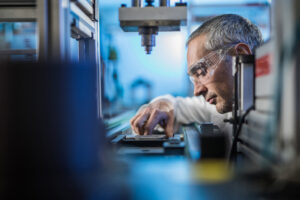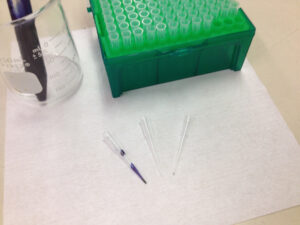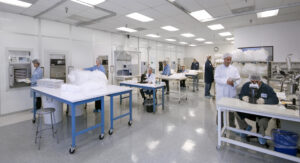
Outsourcing plasma treatments for surface modification
EP&T Magazine
Electronics Production / Materials Contract Manufacturing Medical medical medical plasma plasma treatments treatmentsMedicaldDevice manufacturers turn to contract processors to enhance product’s value
In the medical device industry, plasma treatments are often utilized to solve problems that cannot be resolved other ways. Whether attempting to improve adhesion of dissimilar materials, depositing coatings, cleaning surfaces, applying a protective coating that repels water for example or biological fluids or enhancing surface wettability or functional coating, plasma treatments often add significant value to medical devices.

For many medical device manufacturers, the application of plasma-applied coatings and surface treatments can play a significant role in new product development, but also when upgrading legacy medical devices under 510(k) guidelines. As a result, the industry is aggressively investigating and applying plasma to products such as well plates, microfluids, IOL’s, stainless-steel guide wires, cardiac pacemaker or implantable cardioverter defibrillators (ICD), catheters, stents, and vascular surgical tools.
“Medical device manufacturers are continuously looking for unique ways to technologically advance their products to be the market leader,” says Michael Barden of PVA TePla, a company that designs and manufactures plasma system. “Often, the top tier products incorporate some form of advanced coating to functionalize the surface.”
Medical device makers want plasma-treated parts
However, when medical device manufacturers want plasma-treated parts or components without having to invest in in-house equipment, the solution is to utilize a contract processor. In this approach, parts are sent in, treated and returned within 1-2 days, or up to a week for larger volumes. For small or infrequent batches, this can lower the price per part significantly.
The most common application for contract processing is to improve the bonding power of chemical adhesives, whether metal to plastic, silicon to glass, polymers to other polymers, biological content to microtiter plates and even bonding to PTFE. However, it also is used often to clean, activate, chemically graft and deposit a wide range of chemistries on the surface of parts or components.
According to Barden, the companies that tend to opt for contract processing generally fall into two categories. The first has little or no experience with plasma treatments, but may have heard that it can resolve issues or add value to products.

Target for material or chemistry
“For many customers, plasma is not the first thing they have tried, but they have read or heard ‘you may be able to use plasma’ to solve a specific problem,” explains Barden. “They have a target for their material or the chemistry, but very often they don’t know exactly how to get there. So, it can be somewhat experimental.”
When this is the case, the initial capital costs may be a deterrent. Even large medical device manufacturers may opt to avoid purchasing equipment initially if the product is new, or a new version, and production quantities are unknown.
The other type of inquires received are from companies where outsourcing is a core concept of their corporate philosophy. This could also be true for medical device companies that want to develop the product, but only assemble and do final packaging in house, along with contract sub-assemblers.
Plasma Treatments
According to Barden, many contract processing projects involve using plasma to create a high-energy surface to resolve bonding issues with chemical adhesives. Plasma treatments are utilized to increase the surface free energy of the material to be bonded. When a substrate has a high surface energy, it tends to attract. For this reason, adhesives and other liquids often spread more easily across the surface. This wettability promotes superior adhesion.
Adhesion promotion can be achieved by increasing the surface free energy through several mechanisms, including precision cleaning, chemically or physically modifying the surface, increasing surface area by roughening and primer coatings. The net effect is a tremendous improvement in bonding. In some cases, up to a 50 times bond strength improvement can be achieved.
On the other hand, substrates that have a low surface energy, such as PTFE, are difficult to adhere to other materials without first selectively altering the surface to increase the free energy.
Hydrophobic surface is very difficult to bond to
“When a surface is really hydrophobic, like Teflon, it’s very difficult to bond to it,” says Barden. “If you apply a liquid or adhesive, by nature it pools and will not spread effectively across the surface.”
There are several plasma methods employed to increase surface energy, including physical and chemical plasmas along with PECVD coating surfaces. Silicon, another material widely used in the industry for its low surface energy, often it is utilized as an over-molding compound to protect electronic boards from extreme conditions.
Unfortunately, the topography of a pcb means the silicone must bond to many types of materials, including polymers, metals, alloys, ceramics and the FR-4 board itself, all of which have unique surface energies and chemistries. Without proper adhesion, silicone can begin to delaminate, not only at the edges of the pcb board but also in the form of small air pockets on, or around, components. This can lead to moisture ingress and subsequent corrosion or electrical shorts. 
Plasma process can harmonize all surfaces
“In terms of surface energy, the best strategy is to deposit a thin film coating over everything so the silicone only has to bond to one surface energy,” says Barden. “A process using plasma can basically harmonize all of the many surfaces and turn it into one.”
Gas plasma can also provide surface conditioning of in vitro diagnostic platforms prior to the adsorption of biological molecules (protein/antibody, cells, carbohydrate, etc.) or biomimetic polymers. This includes precision cleaning of the substrate at the molecular level, along with raising the surface energy to improve surface assimilation of the intended content.
“Microtiter and multiwell plates are often made of polystyrene, which is extremely hydrophobic. Water will bead on it,” says Barden. “However, if you treat polystyrene with oxygen plasma it will become very hydrophilic, so liquid spreads everywhere. This allows aqueous solutions containing biological content to spread and deliver biomolecules to the surface while providing a hydrogen bonding platform to adhere them.”
However, some in vitro diagnostic substrates require more selective surface chemistry to immobilize a customer’s proprietary molecules.
Combination of resources
Contract processors should ideally bring a combination of resources for plasma R&D and experience with many customer types in markets beyond medical devices. Working with a contract processor also has tremendous advantages when it comes to tapping into the years of technical expertise applying a variety of plasma treatments. This can often speed research and development efforts significantly. An extensive knowledge and experience manufacturing plasma equipment is also a plus, given that most contract processors just purchase equipment from global providers.
However, with a background in plasma equipment manufacturer, the contract processor can provide critical insight on validation, production methods, fixturing, as well as hardware and software modifications. Examples include special hardware for batch processing, such as a mass flow controller, a different pump configuration or unique chamber sizes.
Additional specifications for a process for electronic part, anti-static so when it comes out of the plasma because it’s an electron emitter, it can accumulate static; Anti-static fans can be used to remove static on the parts when the chamber is opened.
Strict industry requirements
“Depending on the application and complexity, customers face strict industry requirements and often have unique product of processing requirements,” explains Barden.
Even the way the parts are delivered to the contract processor, or how they are packaged and returned can be modified as needed. Parts can be sent in specific counts in bags or in specifically designed pre-loaded trays, for example. Once treated, the parts are typically packaged in polyethylene bags, but for customers with electronic devices like pcbs, antistatic bags can be specified to protect components from electrostatic discharge (ESD).
For medical device manufacturers interested in treating parts and components with plasma, but do not want to make the investment just yet, or require only small batches, outsourcing it to a qualified contract processor could be the solution they are seeking.
